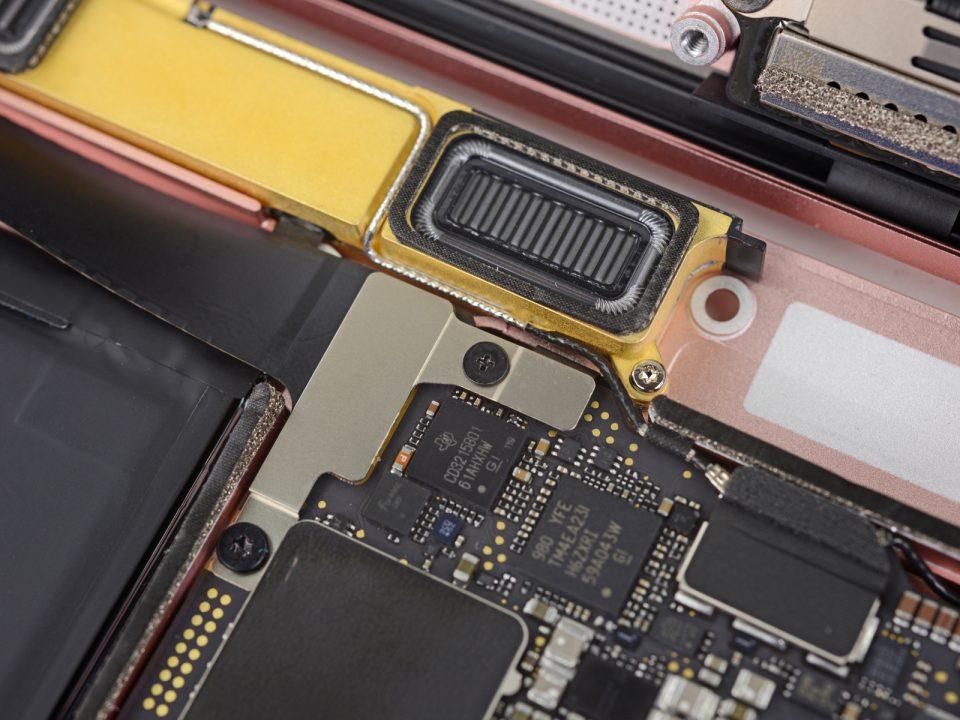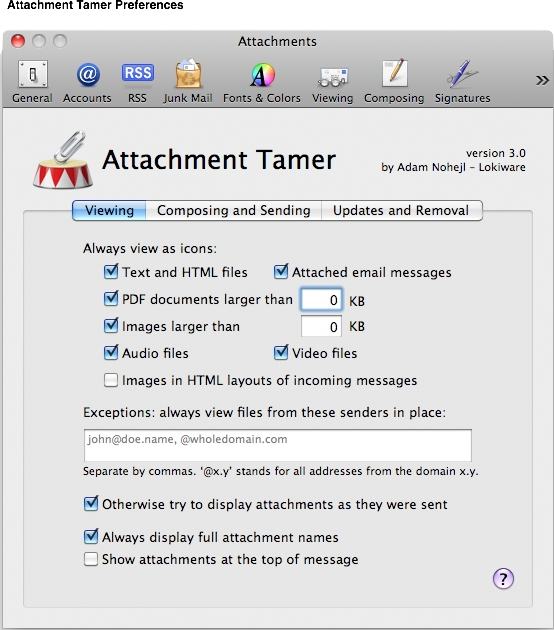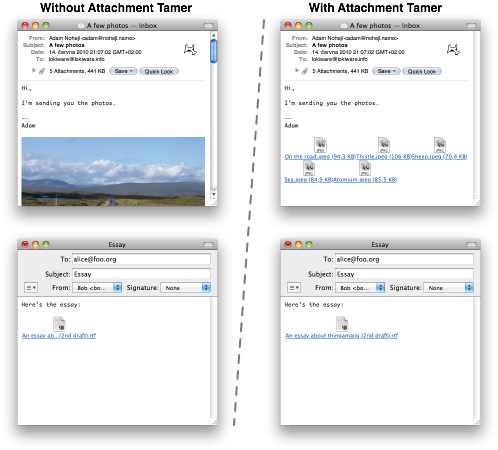

Recipients will get both the message text and the files intact. ◊ Send attachments in compatible format: The compatible format puts an end to broken messages and the dreaded “ATT000x” attachments: images displayed in place are always embedded in HTML ensuring they will be displayed in place, while other attachments are safely withdrawn from the message layout and placeholder text is inserted at their original locations. Note: Changes in settings may not take effect until you close and reopen the window in which messages are displayed.Ĭomposing and Sending - How attachments are inserted into messages and sent (Mail in Mac OS X 10.6 and earlier can display this list even without Attachment Tamer, but you have to open it manually in each message.) Note: This option currently is not available on Mac OS X 10.7 Lion. ◊ Show attachments at the top of message: with this option on Mail will display a list of attachments below headers in incoming messages.
#Attachment tamer mac full#
◊ Always display full attachment names: with this option on Mail will always display full attachment names regardless of length instead of truncated names with ellipsis (…). You will still be able to independently set up how new attachments are inserted into messages in the Composing and Sending tab. Tip: If you want attachments to be displayed in place by default (this is what Mail does without Attachment Tamer), disable the Otherwise try to display attachments as they were sent option in addition to adjustments to the file type based options. For instance, if you select this option and have all images above 100 KB always displayed as icons, then any smaller images would be displayed as the sender intended: either as icons, or in place. Use this option to make Mail respect this information in cases not controlled by the setup you made by the above options. Apple Mail usually ignores it and always displays attachments in place. ◊ Otherwise try to display attachments as they were sent: Email messages usually contain hidden information about how attachments should be displayed (this information is called content disposition). This is useful for instance when you receive voicemail via email and want to play it directly in the message or if you send yourself photos from a mobile phone. ◊ Exceptions: If you receive attachments from specific email addresses that you want display in place regardless of the other settings, you can add these addresses to the list of exceptions. (Read more about rich (HTML) messages and images.) Select this option only If you do not want images to appear in any messages at all.
This is why the option for images in HTML layouts is separate.

◊ Images in HTML layouts of incoming messages: Rich text messages, formatted using HTML in exactly the same way as web pages are, often have a layout that is based on or includes images, therefore these images are generally meant to be displayed in place. Additionally you can set an optional file size limit for images and PDFs. Select this option to have these files displayed as icons.
#Attachment tamer mac pdf#
◊ PDF documents, Images, Audio files, and Video files: By default Mail displays all images, one-page PDF documents, audio and video files directly in the message. Select this option to display attached email messages as icons.

◊ Attached email messages: As with text and HTML attachments, Mail occasionally displays attached email messages directly in the enclosing message. Select this option to ensure that this never happens. Unfortunately when this occurs, you cannot see the boundaries of the files or open them in an external application. ◊ Text and HTML files: Mail sometimes treats text or HTML files as if they were part of the message. The key options in the viewing tab allow you to set up when attachments are displayed as icons: Updates and Removal, where you can set up automated checking for updates, to reset settings to factory defaults, to unregister, or to uninstall Attachment Tamer.Advanced, where you can configure various options related to specific problems,.Composing and Sending, where you can set up how attachments are inserted into a message and sent,.Viewing, where you can set up how attachments are displayed,.The preference pane is divided into four tabs: Alternatively, you may right-click (control-click) any attachment and choose Attachment Preferences from its contextual menu.


 0 kommentar(er)
0 kommentar(er)
